#Amateur Paleontologist
Text

Archaeopteryx Sarcasm
#Archaeopteryx#Feathered Dinosaur#Dinosaur#Dinosaurs#Paleontology#Paleontologist#Amateur Paleontologist
532 notes
·
View notes
Text

[ wip, workin on colors ehehe ]
timeskip zero gang!!
(check my "sv timeskip" tag for more info on them :3)
#pokemon#pokemon scarlet violet#pokemon sv#sv timeskip#my art#wip#notes from prev posts abt it + extras:#10 years after game events (scarlet + htaz specifically)#ages - arven 27 nemona 26 penny 24 florian 23#arven's a part time chef at treasury eatery#nemona's top champion (rika takes over chairman duties)#penny's starting a tech security company (while also doing#florian's an adventurer and amateur archaelogist/paleontologist#arven/nemona are engaged but still call each other my wife (arven's been agender butch lesbianified)#(they're also trying to figure out regulations to allow for safe use of paradox pokemon in league battles)#florian's been in an ldr w kieran for a while now#penny has an on/off deal with carmine she doesn't really talk about much#team's gotta come back together to find out why the time machine's back on - why they can't access the zero lab anymore#and why there are robotic pokemon showing up in area zero + paldea
22 notes
·
View notes
Text
Trying to watch documentaries about your field of study is so frustrating. Yes I know we have a common ancestor with chimpanzees; why did you take ten minutes to explain that?! Everyone knows that! Right? Right!? Of course chimps are built for climbing but tell me why! Are you gonna talk about their shoulder joints or aren’t you? Yes, yes, the hand-feet, we’ve all seen them. Shoulder joints are way more interesting. Shut up about the hand-feet.
#i'm so mad#i tried to watch three different paleoanthro documentaries#the first one was made by an amateur. the second was as much about ice age megafauna as anything. and the third was this.#i'm learning that if their main narrator/informant is not a paleoanthropologist that's a red flag#paleontologist? great now we're gonna spend an hour talking about megafauna. anatomist? honestly i have no idea why they're here#i don't need to hear someone go on about the evolution of bipedalism for ten minutes without even mentioning the anatomical changes#that made it possible. tell me about the foramen magnum! tell me about the pelvis! tell me about knees!#and shoulders! and finger bones! tell me how we developed non-grasping feet!#if you're not going to talk about those then what are we even doing here#hylian rambles#anthropology#paleoanthropology#hominins
30 notes
·
View notes
Text
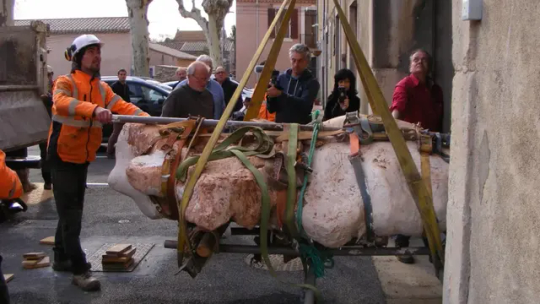
A 70 Million-Year-Old Titanosaur Dinosaur Skeleton Found in France
A chance discovery made in southern France has revealed a rare specimen — an almost complete dinosaur skeleton found connected from its hind skull to its tail.
The massive fossil came to light in May 2022, after now 25-year-old amateur paleontologist Damien Boschetto and his dog stumbled across something unusual while walking in a forest in Montouliers, France. Boschetto had noticed a cliff edge that had recently collapsed and decided to take a closer look, when he spotted an exposed bone sticking out of the ground, local media outlet France Bleu first reported on February 13.
The Archaeological and Paleontological Cultural Association at the Cruzy Museum, in collaboration with the French National Center for Scientific Research, identified the nearly 10-meter-long (32.8-foot-long) fossil as a Titanosaur skeleton upon excavation. Boschetto, who has been a member of the association for eight years, said that while unearthing dinosaur remains is “always exciting and interesting for scientific research and the understanding of the ecosystems of that time,” finding the bones in their almost original anatomical position is what makes this find extraordinary.
“From a museography point of view, it will make it possible to present to the general public animals almost complete in anatomical positions, which is something great,” Boschetto added via email.
A group of history and archaeology enthusiasts created the Archaeological and Paleontological Cultural Association in 1975 to safeguard the heritage around the village of Cruzy, with several members becoming enlightened amateurs in paleontology due to the areas’ wealth of dinosaur fossils, said Jean-Marc Veyssières, a member of the group and one of the fossil preparers for this discovery. Today, the association is made up of inhabitants of the region, including a few scientists as well as students.
“The most exciting thing was to realize that we had at least one anatomically connected animal and that it was a titanosaur, a long-necked dinosaur,” said Veyssières in an email. “(Boschetto) is an enlightened enthusiast and curious about nature, he spends a lot of time surveying the region in search of new areas. … He became an expert on the Late Cretaceous fauna of our region.”
The association has been excavating the site, which Boschetto referred to as a bone bed, a term used by paleontologists to describe a dense area of animal bones and other fossilized remains, for the past two years. And the newly announced find was not Boschetto’s first.

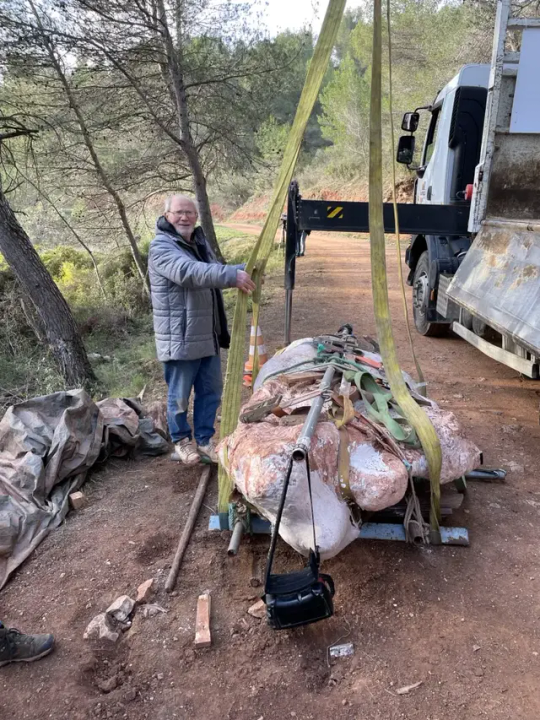
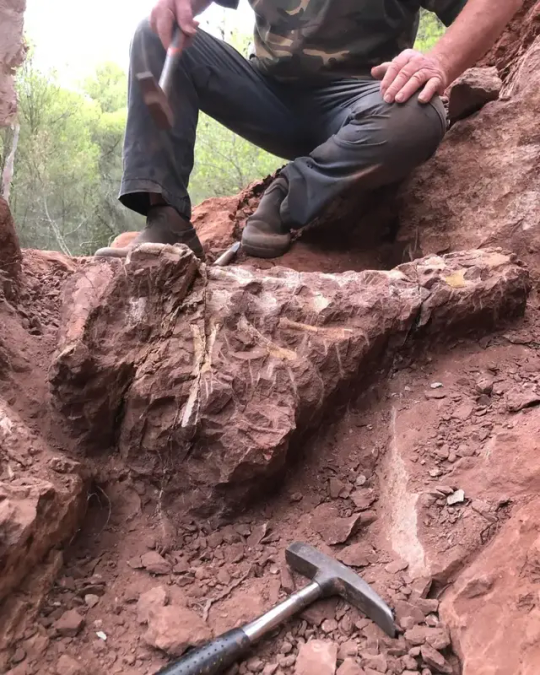
The recently revealed 70% complete Titanosaur skeleton was retrieved during the excavation along with several fossils of various dinosaurs and other vertebrates, including some in anatomical connection and near complete. Other remains identified included those of a Rhabdodon — a herbivore, or plant-eater, like the Titanosaur — and fragments from skeletons of carnivores such as Theropods and crocodiles, according to Boschetto.
The Titanosaur skeleton currently resides in the Cruzy Museum’s laboratory, where it will be further studied, Veyssières said.
Titanosaur found intact
Researchers estimated the age of the newly discovered fossil to be around 70 to 72 million years old, but Titanosaurs roamed around on four legs from the Late Jurassic Epoch to the end of the Cretaceous Period, approximately 163.5 million to 66 million years ago. Titanosaurs belong to a larger group of dinosaurs known as sauropods, a family of long-necked herbivores that were some of the largest dinosaurs of their time, according to Britannica.
Remains of Titanosaur fossils are widely unearthed in Europe, but few are discovered in anatomical connection, Boschetto said. Finding a skeleton in this connected state suggests that the body was buried before it had entirely decomposed, leaving “some tissues connecting the bones to one another,” said Matthew Carrano, research geologist and curator of Dinosauria at the Smithsonian Institution National Museum of Natural History.


The completeness of the specimen will “make it easier to determine whether it’s a new species or a new specimen of a species that’s already known,” Carrano said in an email. “It will take time to learn all the details about this new specimen, but I’m sure it will provide important new information about this group of dinosaurs.”
The region in which Boschetto discovered the specimen is known to be rich in fossils of dinosaurs and other species living at the same time and is “building one of the largest collections of dinosaurs from the Upper Cretaceous in France,” he said. The association did not publicize the discovery until excavation was complete to protect the archaeological site, he added.
The association plans to continue research on the fossils and to further search the area, and the group’s members hope to obtain the funds to “create a large-scale museum that can accommodate and present these collections,” Boschetto said.
By Taylor Nicioli.
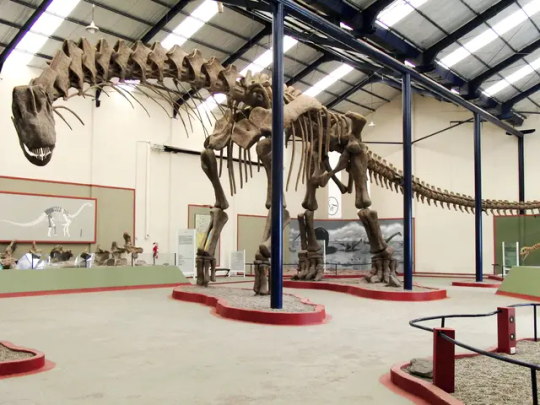


#A 70 Million-Year-Old Titanosaur Dinosaur Skeleton Found in France#Montouliers France#paleontologist#dinosaurs#fossils#ancient artifacts#archeology#archeolgst#history#history news#ancient history
385 notes
·
View notes
Text
#RDR2#Red Dead Redemption#Red Dead Redemption 2#tried to focus on quests that are more character / personality based#than game based#Only reason the paleontologist is on here is cause the interaction between her and Arthur is funny enough#even though your hunting dino bones most of the time than talking to her
106 notes
·
View notes
Text
Y’all ever get sad about the Synapsids? Like they were a massive clade, they ruled* the world before the Dinosaurs and pterosaurs, they had freaking Dimetrodon as a member, and then they all died out except for one branch: the mammals. And mammals might be doing well right now, although at the rate capitalism wrecks stuff who knows, but do you ever mourn our cousins? Do you ever cry about the rest of the synapsids? Like, do y’all ever watch Walking with Monsters and start to feel heavy in your chest? Do you start thinking of lines from the intro to the novelization of Revenge of the Sith when that special gets to its final segment?
I know I am not a even an amateur paleontologist, but as a human watching the world die and change around us, a clade ending hurts. And worse, I can’t imagine past it. I write plenty of superhero settings, but all of their futures are the climate crisis spiraling out of control. Even the future where humanity is still alive the Earth is unstable and global society collapsed. And in the worse ones so many more clades have died out than in our time.
Anyway I’m just babbling because I remembered that I am annoyed the dinosaur episode of Puppet History for getting minor details wrong and because the song in the episode makes me feel raw. I actually don’t watch the episode any more because it hurts too much.
*I know I know, no clade really rules the Earth, evolution and adaptation is not about dominance. Plus I am pretty sure arthropods outnumber vertebrates in population and biomass by a ton.
7 notes
·
View notes
Text
A mischievous god, a reverend and a newly engaged man: Tom Hiddleston has been busy
by Bob Strauss. Photos: Jay L. Clendenin / Los Angeles Times

It hardly needs saying, but Tom Hiddleston is a much nicer guy than Loki, the supervillain he’s played in six Marvel movies and an acclaimed Disney+ series, which just started shooting its second season in England.
And despite the Norse God of Mischief’s ubiquity, the Cambridge and Royal Academy of Dramatic Art-educated actor does have other interests. His stage résumé is as impressive as the array of auteurs he’s made movies with: Joanna Hogg, Steven Spielberg, Woody Allen, Terence Davies, Jim Jarmusch, Guillermo del Toro, Ben Wheatley. There’s also prestige TV such as “The Night Manager” and now “The Essex Serpent,” which launched in May on Apple TV+.
Still, “‘Loki,’ ‘Essex Serpent,’ they have occupied the last two years of my life,” Hiddleston notes on a warm afternoon in an L.A. hotel garden.
Of course, there was more to the last several years than “Essex” and the first season of “Loki.” Hiddleston found time in March to propose to Zawe Ashton, his co-star in a 2019 West End revival of Harold Pinter’s “Betrayal.”
“I’m very happy” is all he wants to say about that, perhaps gun-shy regarding personal matters since a super-scrutinized 2016 romance with Taylor Swift. But just get him started on the latest shows ....
“I love playing Loki, have loved playing him every time,” the actor says about Thor’s shape-and-loyalty-shifting brother. “In every story, there’s been a different iteration, a different director, a different spin on the ball, if you like.”
The “Loki” series takes place in a divergent timeline before/after he was killed in the last two “Avengers” movies. This trickster version is detained by a kind of cosmic bureaucracy, the Time Variance Authority, and stripped of his powers if not his arrogance.
“If you take away everything that the character knows and understands, what remains?” Hiddleston submits. “Something will be revealed to us and to Loki about who he is. This idea of him undergoing an almost psychoanalytical interrogation with the TVA’s Mobius, played by Owen Wilson, and being confronted with repetitive patterns of destructive behavior, which only resulted in his loss and loneliness, I found to be extremely exciting.”
Another first, for Marvel and Loki: He came out as bisexual to the series’ other key frenemy, Sophia Di Martino’s Sylvie, a female variant of himself.
“In my research into the character and the ancient stories, Loki’s identity has always been fluid in his gender and sexuality,” Hiddleston notes. “It was a privilege to touch on it this time. I’m aware it’s a small step and there’s further to go, but I hope that people felt represented by it.”
Contemporary concerns are also represented in Sarah Perry’s bestselling historical novel “The Essex Serpent.” It’s set in a scientifically advancing 1893, while superstitions still haunt the Blackwater Estuary on England’s eastern coast. People go missing, a big underwater thing is bumping into fishermen’s boats, and some believe a folklore dragon has returned.
Claire Danes plays Cora Seaborne, recently widowed from an abusive marriage and an amateur paleontologist, who comes up from London to investigate. An attraction grows between her and the local, married vicar, Hiddleston’s Will Ransome. All six episodes were directed by another of the actor’s admired auteurs, Clio Barnard (“The Arbor,” “Dark River”).
“I loved this combination of her and the story,” Hiddleston says. “It deals with some very resonant themes: uncertainty, fear and how fear of what we don’t understand can sometimes collectively distort reality. There’s an ideological debate between science and religion that’s staged in the dynamic between Cora and my character, the very progressive but nevertheless faithful reverend of the community.

“In my research into the character and the ancient stories, Loki’s identity has always been fluid in his gender and sexuality,” Hiddleston notes. “It was a privilege to touch on it this time. I’m aware it’s a small step and there’s further to go, but I hope that people felt represented by it.”
“It felt like with the pandemic, we all had to manage so much uncertainty,” he continues. “It’s about that, but of course there’s a very psychological metaphor about the serpent, things that lie beneath the surface.”
Hiddleston tried to be a gracious host to his American co-star when they filmed in the Essex salt marshes 13 months ago but fears he might have gone too far.
“It’s windy and it’s muddy and it’s wet,” he says of the shoot. “Claire was incredibly game about all of that. I became a kind of cliché Englishman, endlessly promising that the weather would improve. Every day I’d be like, ‘It’s going to get better, Claire! Just you wait, the spring in England is lovely!’”
Cliché, or in actuality a particularly nice chap?
“I was very lucky when I was younger,” Hiddleston reckons, regarding his reputation. “I worked with some great actors, and I could see that they were very committed to the work and very kind, inspiring in that way. I was junior to Kenneth Branagh and Judi Dench and Chiwetel Ejiofor and Ewan McGregor; these are the best of guys doing it.
“I try to put my best foot forward,” he concludes, then adds with a sheepish grin, “It’s hard to address that.”
76 notes
·
View notes
Photo





Book Recommendations: Tolkien Reading Day
Learn more about Tolkien Reading Day and the Tolkien Society here!
The Science of Middle-Earth edited by Roland Lehoucq, Loïc Mangin, Jean-Sébastien Steyer and illustrated by Arnaud Rafaelian
The world J.R.R. Tolkien created is one of the most beloved in all of literature, and continues to capture hearts and imaginations around the world. From Oxford to ComiCon, the Middle Earth is analyzed and interpreted through a multitude of perspectives.
But one essential facet of Tolkien and his Middle Earth has been overlooked: science. This great writer, creator of worlds and unforgettable character, and inventor of language was also a scientific autodidact, with an innate interest and grasp of botany, paleontologist and geologist, with additional passions for archeology and chemistry.
Tolkien was an acute observer of flora and fauna and mined the minds of his scientific friends about ocean currents and volcanoes. It is these layers science that give his imaginary universe—and the creatures and characters that inhabit it—such concreteness. Within this gorgeously illustrated edition, a range of scientists—from astrophysicists to physicians, botanists to volcanologists—explore Tolkien’s novels, poems, and letters to reveal their fascinating scientific roots.
Exploring J.R.R. Tolkien’s The Hobbit by Corey Olsen
The Hobbit is one of the most widely read and best-loved books of the twentieth century. In December 2012, millions were introduced or reintroduced to J.R.R. Tolkien's classic with the arrival of the first of two film adaptations by acclaimed director Peter Jackson. Exploring The Hobbit is a fun, thoughtful, and insightful companion volume, designed to bring a thorough and original new reading of this great work to a general audience. Professor Corey Olsen (also known as the Tolkien Professor) will take readers on an in-depth journey through The Hobbit chapter by chapter, revealing the stories within the story: the dark desires of dwarves and the sublime laughter of elves, the nature of evil and its hopelessness, the mystery of divine providence and human choice, and, most of all, the revolutions within the life of Bilbo Baggins. Exploring The Hobbit is a book that will make The Hobbit come alive for readers as never before.
The Art of the Hobbit illustrated by J.R.R. Tolkien
When J.R.R. Tolkien wrote The Hobbit, he was already an accomplished amateur artist, and drew illustrations for his book while it was still in manuscript. The Hobbit as first printed had ten black and white pictures, two maps, and binding and dust-jacket designs by its author. Later, Tolkien also painted five scenes for colour plates which are some of his best work. His illustrations for The Hobbit add an extra dimension to that remarkable book, and have long influenced how readers imagine Bilbo Baggins and his world.
To celebrate the 75th anniversary of the publication of The Hobbit, the complete artwork created by the author for his story has been collected in The Art of The Hobbit by J.R.R. Tolkien. Including related pictures, more than one hundred sketches, drawings, paintings, maps, and plans are presented here, preliminary and alternate versions and experimental designs as well as finished art. Some of these images are now published for the first time, and others for the first time in colour. Fresh digital scans from the Bodleian Libraries in Oxford and Marquette University in Wisconsin allow Tolkien’s Hobbit pictures to be seen more vividly than ever before.
The Fellowship by Philip Zaleski & Carol Zaleski
C.S. Lewis is the twentieth century’s most widely read Christian writer and J.R.R. Tolkien its most beloved mythmaker. For three decades, they and their closest associates formed a literary club known as the Inklings, which met weekly in Lewis’s Oxford rooms and in nearby pubs. They discussed literature, religion, and ideas; read aloud from works in progress; took philosophical rambles in woods and fields; gave one another companionship and criticism; and, in the process, rewrote the cultural history of modern times.
In The Fellowship, Philip and Carol Zaleski offer the first complete rendering of the Inklings’ lives and works. C. S. Lewis accepts Jesus Christ while riding in the sidecar of his brother's motorcycle, maps the medieval and Renaissance mind, becomes a world-famous evangelist and moral satirist, and creates new forms of religiously attuned fiction while wrestling with personal crises. J.R.R. Tolkien transmutes an invented mythology into gripping story in The Lord of the Rings, while conducting groundbreaking Old English scholarship and elucidating, for family and friends, the Catholic teachings at the heart of his vision. Owen Barfield, a philosopher for whom language is the key to all mysteries, becomes Lewis's favorite sparring partner, and, for a time, Saul Bellow's chosen guru. And Charles Williams, poet, author of "supernatural shockers," and strange acolyte of romantic love, turns his everyday life into a mystical pageant.
Romantics who scorned rebellion, fantasists who prized reality, wartime writers who believed in hope, Christians with cosmic reach, the Inklings sought to revitalize literature and faith in the twentieth century's darkest years--and did so in dazzling style.
The Elven Cookbook by Robert Tuesley Anderson
From Elrond’s famous feasts at Rivendell to Galadriel’s gift of Lembas Bread to the Fellowship of the Ring, the foods made by Tolkien’s Elves are mysterious, ethereal, and elegant. The Elven Cookbook provides readers with an experience from the world of Tolkien like no other, featuring more than 80 delicious recipes inspired by the mythical race. With recipes such as Silmaril Breakfast Friands, Lúthien’s Asparagus Tart, and Rivendell Roast Lamb, this beautiful cookbook captures all the majesty and otherworldliness of the Elves’ way of life, and delivers a treat for your taste buds and imagination alike.
#jrr tolkien#tolkien#lotr#lord of the rings#middle earth#Nonfiction Reading#Nonfiction#nonfiction books#nonfiction reads#Library Books#Book Recommendations#book recs#Reading Recs#reading recommendations#TBR pile#tbr#to read#tbrpile#Want To Read#Booklr#book tumblr#book blog#library blog
16 notes
·
View notes
Note
🌻 If you get this, answer with 3 random facts about yourself and send it to the last 7 blogs in your notes, anonymous or not! Let's get to know the person behind the blog 🌻
from: @thelazywitchphotographer
Three random facts, huh?
*taps chin thoughtfully*
1) I wanted to be a paleontologist for eleven years. At this point, I've forgotten more things about dinosaurs than most people will ever know. I still have many books, toys, and skeletons, though.
2) Before I took up the hobby of writing, my main hobby was drawing. I'm about… ten years out of practice with drawing, though. When I do draw, I stick to chibi style because realistic is just too draining for me.
3) I'm an amateur gardener. I had a lot of success with potatoes (they're pretty basic, though), and I have also harvest and dried lavender and oregano. The lavender went especially well, and I plan to do it again, though probably not this year.
Thanks for the ask! :D
3 notes
·
View notes
Text
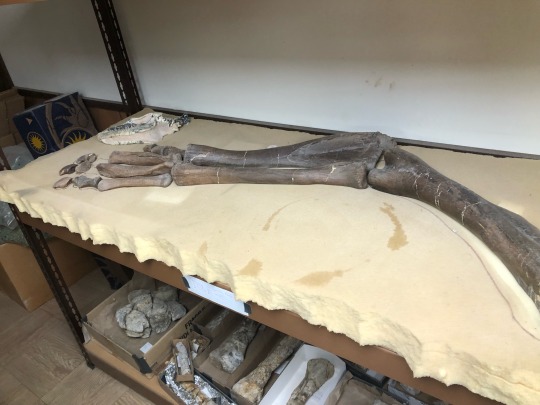
My uncle who owns a chocolate company and is also an amateur paleontologist (because why not) took us on a tour of his chocolate factory/dino lab and showed us this incredibly well preserved hadrosaur arm. And also let us sample chocolate. We’re having a fun day!
#ive never known anyone who lives their passions quite like him#he’s a real character#he’s bought some land to try to build a whole dinosaur musuem#it’s just so cool
18 notes
·
View notes
Text
Baryonyx
The Baryonyx is the first ever fish-eating dinosaur to have been discovered, however do not be fooled, they likely ate other dinosaurs as well.
Paleontologists believed that they would sweep their claws back and forth in rivers before snatching a fish, similar to how a brown bear does. They likely didn’t stray far from lakes and rivers so as to remain near their likely main source of food.
They lived about 130 million years ago, either during the early or middle Cretaceous, which is odd for a theropod due to most of them having lived in the late Cretaceous.
The Baryonux was about 9 feet tall and 31 feet long and weighed approimately 2 tons. They had 2 undersized arms, a small crest on their snout and a crocodilian-like jaw with over 95 teeth. They have a largre claw on their first finger which was about 30 cm long.
Their name Baryonyx means “heavy claw”, and walkeri refers to the young fossil hunter William J. Waller who founded them.
They were discovered n 1983 by amateur paleontologist William Walker in the UK, however it wasn’t until 1986 that they were named and described by paleontologists Alan J. Charig and Angela C. Milner. It was one of the first carnivorous dinosaurs discovered in England.
They have been found in Spain, Portugal and the U.K.
They are a theropod, who is closely related to the Spinosaurus, Suchomimus, and Carcharodontosaurus. All 4 are known for their crocodilian-like snouts.

4 notes
·
View notes
Text

SV Timeskip Zero Gang designs!!
feel free to shoot any questions my way if you're curious about them, but lil notes on post-timeskip stuff under the cut:
10 years after game events (Scarlet + HToAZ, specifically)
Arven's 27 and a part time chef at Treasury Eatery
Nemona's 26 and Top Champion (Rika takes over League Chairman duties)
Penny's starting a tech security company
Florian's an adventurer and amateur paleontologist
extra notes:
Arven and Nemona are engaged but still call each other my wife (Arven's been agender butch lesbianified) - they're also trying to figure out regulations to allow for safe use of Paradox Pokémon in league battles
Florian's been in an LDR with Kieran for a while now
Penny has an on/off deal with Carmine she doesn't really talk about much
10 years after it shut down thanks to the efforts of the Zero Gang and Koraidon, the time machine has mysteriously turned back on and is bringing more Paradox Pokémon to the present. However, these new Paradox Pokémon are robotic - not at all like the Ancient Pokémon Sada had studied - and seem to resemble several creatures described in issues of Occulture Magazine.
The team's gotta come back together and get help from some friends to figure out what's happened in Area Zero and who's behind it!
#pokemon#pokemon sv#pokemon scarlet violet#pokemon scarvi#timeskip designs#zero gang#sv timeskip#my art#extremely proud of how these guys came out actually#wasn't gonna shade them at first but i needed something to keep my hands occupied during d&d so. lmao#also tried SO HARD not to go overboard w shading and i think i did a lil w penny#but also she's got more stuff that'd interact w light than the others so not that big a deal#ALSO also i think i fuckin. ate w florian's outfit actually. basically just gave him a sygna suit but he wears it all the time ehehehe#koraidon's his best pal (aside from skeledirge)!!! they match now!!!
28 notes
·
View notes
Text
New fossil site of worldwide importance uncovered in southern France.
Nearly 400 exceptionally well-preserved fossils dating back 470 million years have been discovered in the south of France by two amateur paleontologists. This new fossil site of worldwide importance has been analyzed by scientists from the University of Lausanne, in collaboration with the CNRS and international teams. This discovery provides unprecedented information on the polar ecosystems of…

View On WordPress
1 note
·
View note
Text

A stock photo shows a Dinosaur Fossil simulator excavation used for education. Researchers recently discovered the Fossil of a new Aetosaur Species in Texas. IStock/Getty Images
Extinct 'Eagle Lizard' Found in Texas Canyon
— Newsweek | January 19, 2023
Researchers recently learned that a fossil unearthed in 1989 was actually a new reptile species that lived roughly 218 million years ago in what is now a Texas canyon.
The newly identified species, Garzapelta Muelleri, is a type of Aetosaur, which means "Eagle Lizard" because the reptile's skull resembles that of a bird, according to a report by Sci.News. Like alligators, aetosaurs roamed wet regions across the supercontinent Pangea during the Late Triassic Period, the University of California Museum of Paleontology says.
The museum says the aetosaurs were heavily armored with a crocodile's body, pig's snout and bird's skull. The newly discovered reptile was up to 11.5 feet long, according to a study about the newly identified species that was published in The Anatomical Record on January 11.
Aetosaurs were believed to be omnivores and herbivores. They vanished at the end of the Triassic period because of a mass extinction event.
The aetosaur's fossilized skeleton was first found by Paleontologist Bill Mueller from Texas Tech University and local amateur collector Emmett Shedd in 1989 in the Cooper Canyon Formation in Garza County, Texas. But Mueller died in 2019, and many of his projects remained unfinished. William Reyes, a paleontologist and Ph.D. candidate at the University of Texas at Austin, was invited to lead the description of the new species that was published earlier this month in The Anatomical Record.
The skeleton was found along with the creature's carapace, a hard outer shell that is similar to that of a turtle. The study said that the carapace fossil provides "new insight" into carapace variation across the species and that the findings imply that researchers were "dealing with the emergence of a new group of aetosaur."
"Everyone agreed that it was indeed a new species, as it exhibited several unique features in its armor that differentiate it from any other known Aetosaur Species," Reyes told Newsweek. "However, where exactly it fell in the evolutionary tree of this group remained contentious."
Reyes said the next steps in his research include reassessing some of the aetosaur relatives of the Garzapelta Species.
Researchers believe that aetosaurs lived across the world, as their fossils have been found in Europe and North and South America, the University of California museum said. The most common aetosaur fossils that researchers find are the hard plates that make up the body armor, the report said.
The discovery comes after researchers found two new species of an "Iconic and Bizarre" dinosaur group in North America at the end of last year.
Earlier this month, a fossil found by a pair of hikers last year was identified as the skull of a huge new species of prehistoric fish that lived around 72 million years ago.
Researchers also announced the discovery of the remains of a large flying reptile that roamed Earth's skies 100 million years ago during the age of the dinosaurs.
In other locations across the world, scientists are finding that species they thought were extinct are still thriving in the wild, like the De Winton's golden mole in South Africa 🇿🇦 and the Attenborough's long-beaked Echidna in New Guinea 🇬🇳.
"I think it's just fantastic that...we can still rediscover species," said Cobus Theron, a member of the research team that found the golden mole, in a press release. "All of our stories around conservation are doom and gloom. Here we have an opportunity to say that, actually, there are opportunities to make change."
#Newsweek#Dinosaur Fossil#Extinct 'Eagle Lizard'#Fossil#Aetosaur Species#Texas | USA 🇺🇸#Texas Canyon#University of California Museum of Paleontology#Paleontologist | Bill Mueller | Texas Tech University#Garzapelta species#William Reyes | Paleontologist#University of Texas at Austin
0 notes
Link
Check out this listing I just added to my Poshmark closet: E.B. Hall House Wellsville, NY Shelia's Collectibles Shelf Sitter Plaque 1993.
0 notes
Text
The Essex Serpent review – Claire Danes is magnificent … unlike Tom Hiddleston
The Loki actor feels too suave to play a humble vicar in this adaptation of Sarah Parry’s lush novel – which makes the central romance cold and condescending
⭐️⭐️⭐️ / 5
Sometimes a cigar is just a cigar, said Freud. But darlings, let me tell you – a snake is never just a snake. And certainly not in The Essex Serpent (Apple TV+), the new six part miniseries adapted by Anna Symon from Sarah Perry’s 2016 bestselling novel of the same name.
At the tail end of the Victorian era and recently liberated by her wealthy, abusive husband’s death from cancer, young widow Cora Seaborne (Claire Danes) abandons London society and moves to Aldwinter on the edge of the Blackwater marshes to pursue a much more fulfilling life as an amateur paleontologist in comfortable clothes. With her she takes her devoted maidservant Martha (Hayley Squires) and her autistic (in modern day terms) son Frankie. Her husband’s former doctor, Luke Garrett (Frank Dillane), becomes a friend – and, in time, a contender at least in his eyes for her affections – and visits often.
When sightings of the legendary monster of the marshes begin, Cora theorises that it may be a living fossil – an icthyosaur-like being that escaped evolutionary pressures in the ancient wetlands – while the locals cleave to superstition and supernatural explanations for what they call “the Blackwater Beast”. Between the two stands the Rev Will Ransome (Tom Hiddleston), a man of God but also of the Enlightenment, keen to keep the growing fears and fancies of his flock under control and not call on divine or diabolic explanation unless all others have been exhausted. In this, he is not helped by his curate Matthew, a fire and brimstone type (whose name is surely meant to evoke the Witchfinder General Matthew Hopkins, who began his career in Essex in the 17th century) who sees the serpent as a sign from God that urgent repentance of the villagers’ sins is needed.
As the friendship between Will, his ailing wife Stella (Clémence Poesy) and Cora grows, so does the attraction between Will and Cora – rather less convincingly on screen than in the book. Perhaps this is down to a lack of chemistry between the leads, or perhaps the miscasting of Hiddleston, who never manages to shed his innate air of suave confidence. It works well when playing a god of mischief amidst a plethora of equally towering egos in the Marvel Cinematic Universe; less so when playing a Victorian vicar humble enough to admit doubts and wrestle with his conscience. Let alone fall in love with a woman cleverer than him, and spend time offering explanations that he is too honest to dismiss out of hand, however much they pain him. It gives his exchanges with Cora a condescending edge that is the death knell to the love and profound yearning that animated their relationship in the novel.
Danes, on the other hand, is magnificent as Cora – brusque, athletic, undisguisably intelligent and every inch a woman gradually being restored to life and self in the wake of her husband’s brutality. In fact, all the women are wonderful, from Squires, who brings vitality and conviction to what could be the slightly worthy part of the Socialist servant eager to bring about change, via Lily-Rose Aslandogdu and Dixie Egerickx as guilt-stricken youngsters who fear they summoned the beast, to Poesy who – as gentle, watchful Stella, is a heartbroken and heartbreaking revelation.
For all that, there is something strangely cold and sluggish about the adaptation of Perry’s book, which despite being a novel of ideas, was lush and vibrant, too. Although it excavated the links between myth, science and religion, it held up love in all its forms to the light as well. Platonic love, sexual love, requited and unrequited romantic love, love of a child, of a vocation, of discovery, of God. It was Wuthering Heights pulled into shape and given intellectual rigour without losing any of its sweeping gothic passion. But on screen, abundance has become austerity, suppressed feeling shades into inertia and the protagonists keep treading and retreading the same small patch of argumentative ground instead of sparking off each other and forging the greater and greater bond on which the story should turn.
Maybe I am simply too much a fan of the book. Symon’s take works perfectly well as a drama that delivers suitably sinuous twists and, under Clio Barnard’s direction, looks grimly fabulous, emerging out of the marsh mists that seem to promise that any malevolence is possible. And Danes grounds and gives a remarkable truth to the whole. But even allowing for the fact that screen adaptations rarely capture the full filigree of a literary novelist’s work (one reason why uncomplicated genre fiction generally fares better – there is more to add, less to lose), it feels like slightly too much has been lost in translation here.
6 notes
·
View notes